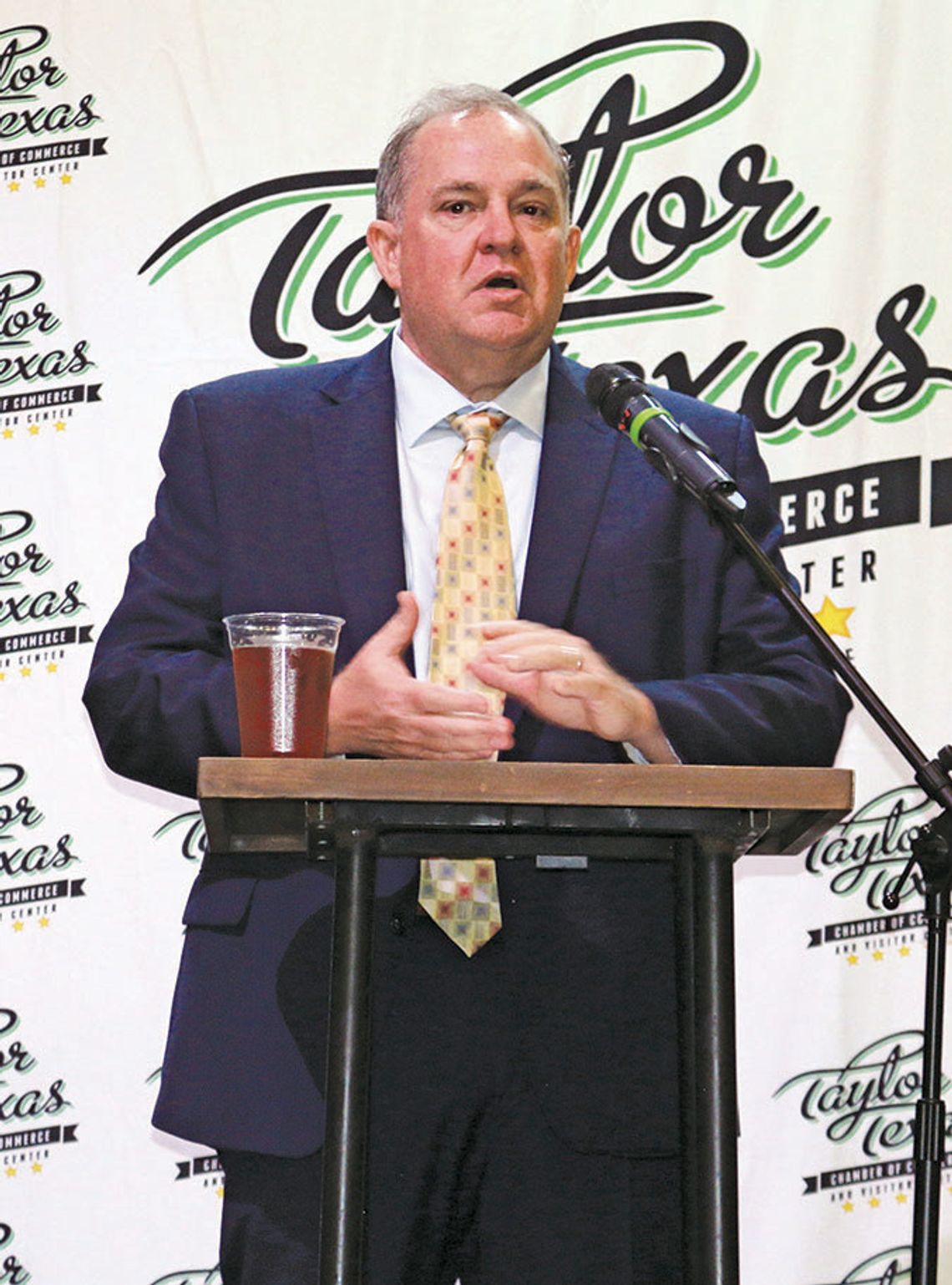A lack of infrastructure — roadways, housing and water — are holding back growth in Williamson County, even as the population rises and more industry locates here, a county commissioner is warning.
Precinct 4 Commissioner Russ Boles pulled no punches Monday, May 19, as he gave an update on the county and local projects at the Greater Taylor Chamber of Commerce monthly luncheon, held at First Baptist Church of Taylor.
Boles said roads, housing and water are the most pressing issues for the area.
“I get asked a lot about who’s in charge. The truth is, we live in a capitalistic society. That’s what controls it at the end of the day,” Boles said in reference to the roles played by city and county governments in managing growth. “It’s the economic forces out there and they want to be here. There’s so much going on here.”
Roads
Transportation is a hot topic on the mind of residents and city and county leaders, the commissioner told his audience.
Photo by Edie Zuvanich Boles said Segment 3 of the East Wilco Highway, which includes a bridge over U.S. 79, will be ready for drivers in mid-June, with a ribboncutting June 20. “It cost over $80 million –– the most expensive project in the history of the county. That’s how important we think Taylor and east Williamson County are,” Boles said. “We are putting our money where our mouth is for y’all.”
Other projects Boles mentioned include adding a traffic signal on CR 138 at East Wilco Highway, building an overpass on Chandler Road at FM 1660, widening Chandler and extending the road to connect the loop around Taylor.
He said the county is also working with the Texas Department of Transportation to add more lanes to the Texas 130 toll road.
“Six years ago, I never thought I would be planning roads east of Taylor. It’s something that y’all need tremendously. (iMarket America) is heading in that direction, a lot of other stuff’s going on in that direction as well,” he added.
Boles encouraged business owners and residents to engage in discussions with city leaders to help form what opportunities Taylor will take advantage of in the future.
“Cities maybe increase their value 3 to 4 percent. In the next two to three years here, we’re looking at potentially 50%. That’s very exciting,” he said. “I know Taylor’s past and the importance the city had. That is where we’re heading again.”
MUDs
The commissioner said growing municipal-utility districts outside of towns are top of mind for cities and the county as they claim more resources. While emerging MUDs provide much-needed housing in answer to a growing population, they can also create a strain on existing infrastructure.
For example, the Sonterra MUD outside of Jarrell numbers 15,000 souls – about the size of Taylor and almost three times the size of Jarrell.
Demographers indicate the area — which includes rapidly expanding cities such as Hutto and Georgetown, and emerging tech-giants like Samsung Austin Semiconductor – needs about 350,000 more single-family homes, but developers counter it is too expensive to build residential neighborhoods within city limits.
State law gives cities more leeway on development restrictions, but fewer exist in unincorporated areas, which is what attracts developers to them. Those same areas have less resources, though, Boles indicated.
Cities including Taylor have requirements about parkland dedication, trees and roadways that the county does not impose.
In addition, a MUD can levy its own taxes on homeowners, with those monies eventually paying the developer back for any infrastructure investments.
In a city, developers have to add that cost into the initial house price. If the market won’t bear the cost, the developer fails to recoup an investment.
But the MUD also has to make arrangements for utilities including water, and water is precious, Boles said.
Water infrastructure is expensive and utilities such as Manville Water Supply Corp. and Jonah Water Special Utility District have a lot of area to cover but no water lines. “The truth is, we would have seen more development in some of these areas except they’re still extending their infrastructure,” Boles said.
Water
Maintaining an adequate water supply is a major concern across Texas, which is seeing a population boom, and the state is working to create more resources including desalinization, Boles said.
The Carrizo-Wilcox Aquifer, which spans Texas from the Louisiana border to the gulf and includes nearby Milam and Lee counties, plays a role in local water concerns.
“That is a phenomenal aquifer that we don’t really completely understand. As has been described to me there’s more water in the Carrizo-Wilcox Aquifer than all the surface water in the state of Texas,” Boles said.
The commissioner said residents need to work with local governments to ensure there is enough water for their families in the future.
“That takes investments and that takes planning. There are a lot of people out there, with a lot of money, vying for those resources,” he said.
Schools
Boles also touched on the importance of school districts, saying that if a community wants to be great it has to have a great school system.
“(Once the Samsung plant is operational), the overall value of the city of Taylor is going to double and that’s great news for the city tax rate, but who that’s really great news for is the (Taylor Independent) School District. Your school district is under immense pressure,” Boles said.








